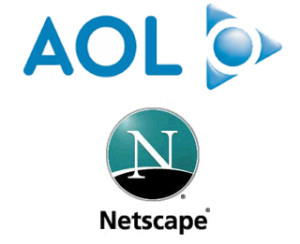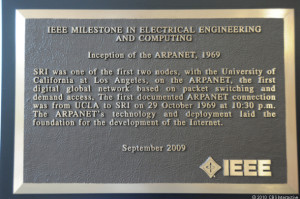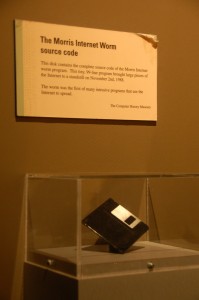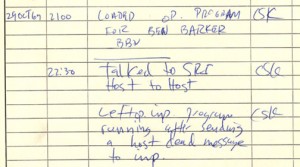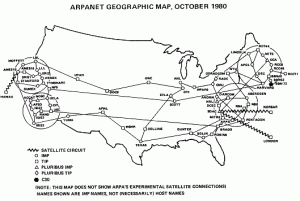The Internet
AOL Buys Netscape
AOL announces it will buy Netscape Communications in a stock-for-stock deal worth approximately $4.2 billion. At the time it was considered a move by AOL and Netscape to merge forces to better compete with Microsoft in the browser and Internet provider markets. However, Microsoft’s dominance in the personal computer market could not be stopped and the Netscape browser lost almost all marketshare to Internet Explorer. In 2003 Microsoft settled a monopoly lawsuit with AOL (then merged with Time Warner) for $750 million over the loss of value of Netscape. AOL itself, once a dominant Internet Service Provider, slowly lost their subscriber base with the evolution of broadband Internet in the 2000’s and operates primarily as a media conglomerate, although their dial-up service still subscribes approximately 2 million users as of 2013.
The Birth of the Internet
A little less than a month after the first test message was sent, the first permanent link on the ARPANet is established between UCLA and the Stanford Research Institute. As the ARPANet was the foundation of the modern Internet, this connection can now be considered the very first link of what we now know as the Internet.
Amazon Ignites the Kindle
Amazon introduces their Kindle e-book reader. Where other companies had released e-book readers in previous years with limited success, the Kindle’s integration with Amazon’s industry leading book distribution system helped catapult the e-reader into the the mainstream consciousness. The Kindle sold out within five hours of its debut.
Conception of the World Wide Web
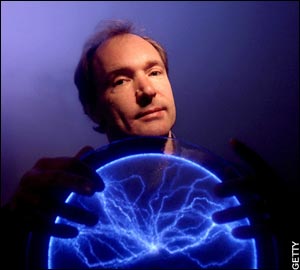 November 12, 1990
November 12, 1990
About 2 and a half years after he first submitted a proposal to his employer, CERN, for developing a new way of linking and sharing information at the European research institution, Tim Berners-Lee submits a formal proposal for a hypertext project he calls “WorldWideWeb”. In this proposal he lays out his vision for what will become the modern World Wide Web. By Christmas Day he will have the prototypes of a web server and web browser operational. By the end of February of the next year he will present the project to his colleagues at CERN. By May the first web server will go online internally at CERN. And by August, having realized the potential for his new system on the Internet at large, he will announce the project publicly on the alt.hypertext usenet group along with the first public web server hosted at CERN.
A Firefox Rises Out of the Ashes
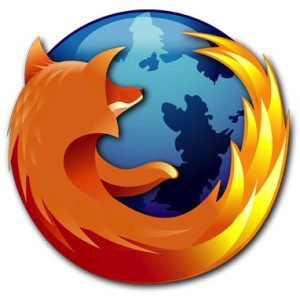
This was the original Firefox logo from 2004
November 9, 2004
The Mozilla Foundation releases version 1.0 of the Firefox web browser. Firefox is significant in Internet history because it represented the first serious alternative to the dominance of Microsoft’s Internet Explorer in several years. By many estimations, Internet Explorer had risen to over 90% of browser marketshare since the downfall of Netscape many years earlier.
It is interesting to note, however, that it was Netscape itself that started the Mozilla project when it released the source code to their Netscape Communicator software in 1998. It was upon this codebase that the foundations of Firefox were laid. Firefox’s original name was Phoenix, seemingly in tribute to the fact that out of the ashes of the fallen Netscape came a new browser.
Pets.com Put to Sleep
After only 2 years in business, Pets.com shuts down operations. Cited as one of the biggest failures of the dot-com bubble, Pets.com was able to gain significant brand recognition through its extensive marketing campaign and sock puppet mascot, but lost money due to an unsustainable business plan. Ironically, the company’s best selling product was its sock puppet. And yes, I own one.
Morris Worm Tunnels Through Internet
Robert Morris of Cornell University launches a self-replicating worm as part of a research project designed to determine the size of the early Internet. It was intended to count the number of computers that initiated connections when the worm was loaded onto them. However, due to a programming error, the “Morris Worm” began repeatedly infecting machines, clogging network traffic and causing machines to crash. Eventually the worm spread to 6,000 machines, which was roughly 10 percent of the Internet at the time, causing significant downtime for government and university systems for two days. Morris was dismissed from Cornell, sentenced to three years probation and a $10,000 fine.
First Message on the Internet
October 29, 1969
UCLA student Charley Kline attempts to transmit the text “login” to a computer at the Stanford Research Institute over the first link on the ARPANET, which was the precursor to the modern Internet. After the letters “l” and “o” are sent the system crashed, making the first message ever sent on the Internet “lo”. About an hour later, after recovering from the crash, the full text of “login” is successfully sent.
First Major ARPANET Outage
October 27, 1980
The ARPANET, the precursor to the modern Internet, stops functioning for about four hours after the network’s routing tables are corrupted by a malfunctioning Interface Message Processor (IMP).
IMDb Launched
Colin Needham, an English movie fan, launches the “rec.arts.movies movie database”, which would later be known as the Internet Movie Database, or IMDb. An engineer working for HP at the time, by 1996 Needham quit his job to work on IMDb full-time. The IMDb is one of the most visited sites on the Internet and was acquired by Amazon in 1998. Needham is still the General Manager of the IMDb to this day.

